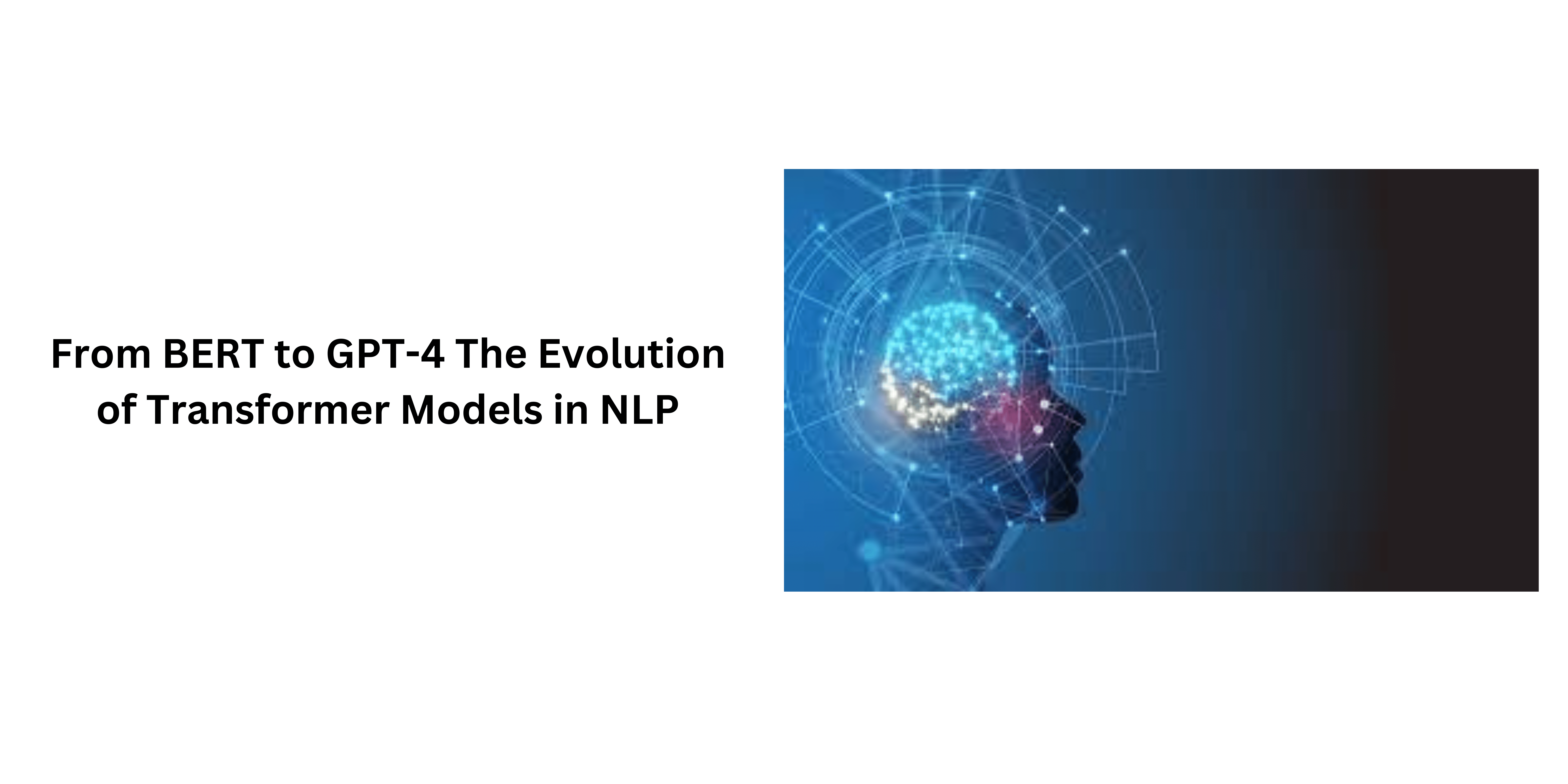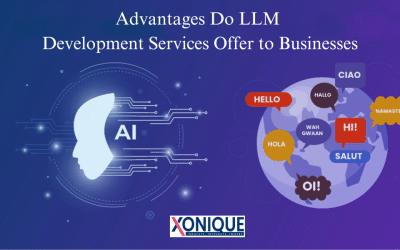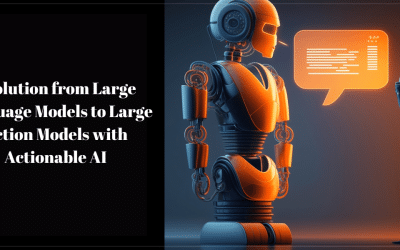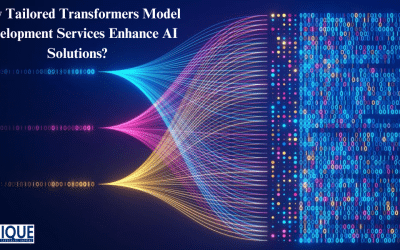In the dynamic landscape of Natural Language Processing (NLP), the evolution of transformer models has been nothing short of revolutionary. From the groundbreaking introduction of BERT to the latest advancements seen in GPT-4, these models have reshaped the way machines comprehend and generate human-like text. The Transformer architecture, introduced by Vaswani et al. in 2017, laid the foundation for these transformative models by allowing for parallelized computation of sequential data, making it highly efficient for NLP tasks.
BERT (Bidirectional Encoder Representations from Transformers) brought forth a paradigm shift by capturing context bidirectionally, overcoming limitations of previous models. Subsequent iterations like GPT-2 and GPT-3 expanded the horizons with generative capabilities, enabling diverse applications.
As we delve into the transition from BERT to GPT-4, it becomes crucial to explore the challenges, breakthroughs, and ethical considerations accompanying this journey. This exploration will provide insights into how these transformer model development services continue to shape the future of NLP, pushing the boundaries of language understanding and generation.
The Emergence of BERT: A Revolutionary NLP Model
The Emergence of BERT (Bidirectional Encoder Representations from Transformers) marked a pivotal moment in the field of Natural Language Processing (NLP), fundamentally altering the landscape of language understanding for machines. Introduced by Google researchers in 2018, BERT represents a revolutionary approach to pre-training language models. Unlike its predecessors, BERT bidirectionally captures contextual information from both the left and right sides of a given word, allowing it to comprehend context more effectively than unidirectional models.
BERT’s innovation lies in its ability to consider the entire context of a word within a sentence, leading to a deeper understanding of semantics and relationships between words. This bidirectional approach addresses the limitation of previous models that relied solely on left-to-right or right-to-left context understanding. The model is pre-trained on massive corpora, acquiring a robust language representation that can be fine-tuned for various downstream NLP tasks.
One of the key breakthroughs with BERT is its applicability to diverse NLP challenges such as question answering, sentiment analysis, and named entity recognition. Its contextualized embeddings enable more accurate predictions, and its versatility has led to widespread adoption in both academia and industry.
BERT’s impact reverberates beyond its impressive performance metrics. Its open-source nature has encouraged collaboration and spurred advancements in subsequent transformer models like GPT-2 and GPT-3. The emergence of BERT represents not just a model but a paradigm shift, ushering in an era where contextualized language understanding is at the forefront of Natural Language Processing services research and application development.
Understanding the Basics of the Transformer Architecture
Understanding the basics of the Transformer architecture is fundamental to grasping the transformative advancements in Natural Language Processing (NLP). Introduced by Vaswani et al. in their seminal paper “Attention is All You Need” in 2017, the Transformer architecture revolutionized the field by dispensing with sequential processing and introducing a mechanism called self-attention.
At its core, a Transformer consists of an encoder-decoder architecture, with each composed of multiple layers. The encoder processes input sequences, such as words in a sentence, while the decoder generates output sequences. Self-attention mechanisms enable the model to weigh different parts of the input sequence differently, allowing it to focus on relevant information.
The key innovation lies in the self-attention mechanism’s ability to capture long-range dependencies and relationships between words in parallel, rather than sequentially. This parallelization significantly accelerates training and inference processes, making Transformers highly scalable and efficient for handling large datasets.
Each layer in the Transformer model development services contains multi-head self-attention mechanisms and feedforward neural networks. The self-attention mechanism computes attention scores for each word in the sequence, capturing its relationship with every other word. This mechanism is crucial for understanding contextual information, enabling the model to consider the entire context of a word during training and inference.
Moreover, the Transformer architecture introduces positional encodings to provide information about the order of words in a sequence, compensating for the lack of inherent sequentially in self-attention. This innovation empowers Transformers to excel in tasks requiring an understanding of context and relationships within a given input sequence, laying the foundation for subsequent transformer-based models in NLP.
BERT’s Impact on Natural Language Processing
BERT (Bidirectional Encoder Representations from Transformers) has left an indelible mark on the field of Natural Language Processing (NLP), reshaping how machines comprehend and generate human-like text. Introduced by Google researchers in 2018, BERT represented a significant departure from traditional NLP models by adopting a bidirectional context understanding approach.
The impact of BERT on NLP is profound due to its ability to capture contextual information bidirectionally, considering the entire context of a word within a sentence. This bidirectional attention mechanism addresses the limitations of earlier unidirectional models, allowing BERT to achieve a deeper and more nuanced understanding of language semantics.
BERT’s pre-training on vast amounts of text data equips it with a rich language representation, making it a versatile model for various downstream NLP tasks. Its contextual embeddings enable more accurate predictions, especially in tasks such as question answering, sentiment analysis, and named entity recognition. BERT’s success in the General Language Understanding Evaluation (GLUE) benchmark demonstrated its effectiveness across a spectrum of NLP challenges.
Beyond performance metrics, BERT’s open-source nature has spurred widespread adoption and encouraged researchers and developers to fine-tune the model for domain-specific applications. The BERT architecture has become a cornerstone for subsequent transformer models, influencing the design of advanced language models like GPT-2 and GPT-3.
In essence, BERT has not only elevated the state-of-the-art in NLP but has also catalysed a paradigm shift in how we approach language understanding in the era of deep learning. Its impact resonates in both academic research and industrial applications, cementing its place as a revolutionary milestone in the evolution of transformer-based models.
Limitations of BERT and the Need for Advancements
While BERT (Bidirectional Encoder Representations from Transformers) has emerged as a groundbreaking model in Natural Language Processing (NLP), it is not without its limitations, prompting the need for continuous advancements in the field. Understanding and addressing these limitations is crucial for pushing the boundaries of language understanding and enhancing the capabilities of transformer-based models.
One prominent limitation of BERT is its lack of true understanding of causality and temporal relationships within a sequence. BERT processes input sequences independently, without inherent knowledge of the order in which words appear. This limitation hinders its performance in tasks that require a nuanced understanding of temporal dynamics, such as discourse analysis or tasks involving time-sensitive information.
Additionally, BERT’s token-based approach has constraints on the maximum sequence length it can handle, posing challenges for processing longer documents or passages. This limitation restricts its applicability in tasks that involve context from extensive textual content.
Another area of improvement is BERT’s sensitivity to input phrasing. While it excels at understanding contextual nuances within a sentence, it may struggle with slight rephrasing or paraphrasing variations, impacting its robustness in certain NLP applications.
Furthermore, BERT’s computational demands are considerable, requiring substantial resources for training and inference. This poses challenges for deployment in resource-constrained environments or on devices with limited computing power.
Addressing these limitations has become a focal point for researchers, leading to ongoing advancements in transformer-based models. The quest for models that can handle longer contexts, understand causality, and exhibit enhanced robustness is driving the evolution from BERT to more sophisticated architectures, ensuring that transformer models continue to evolve and meet the evolving demands of complex NLP tasks.
GPT-2: Expanding the Possibilities of Transformer Models
GPT-2 (Generative Pre-trained Transformer 2) stands as a testament to the relentless pursuit of expanding the capabilities of transformer models in the realm of Natural Language Processing (NLP). Developed by OpenAI and introduced in 2019, GPT-2 significantly pushed the boundaries of what was deemed possible with large-scale language models.
At its core, GPT-2 inherits the transformer architecture’s foundation but scales it to a staggering 1.5 billion parameters, dwarfing its predecessor, the original GPT. The sheer size of GPT-2 contributes to its remarkable ability to generate coherent and contextually relevant text across various tasks. It exhibits a proficiency in tasks such as language translation, text completion, and even creative writing, showcasing a level of fluency and versatility previously unseen.
One of GPT-2’s distinguishing features is its capacity for conditional text generation. By providing a prompt or context, users can steer the model to generate content in a desired style or direction. This fine-tuning capability has applications ranging from content creation to aiding in specific domains where context-aware responses are crucial.
Despite its successes, GPT-2 is not without challenges. Issues like potential biases in generated content and the model’s occasional lack of factual accuracy highlight the ethical considerations surrounding large language models. These concerns, however, have spurred ongoing discussions about responsible AI development and deployment.
GPT-2’s release ignited a wave of interest and research, influencing subsequent transformer-based models like GPT-3. Its legacy is marked not only by its technical achievements but also by the broader conversations it sparked about the responsible use of advanced language models and the ethical considerations inherent in deploying such powerful tools.
Unleashing Generative Power: An Overview of GPT-3
GPT-3 (Generative Pre-trained Transformer 3) represents a quantum leap in the evolution of transformer models, pushing the boundaries of generative capabilities in Natural Language Processing (NLP). Unveiled by OpenAI in 2020, GPT-3 is a colossal language model with a staggering 175 billion parameters, dwarfing its predecessor GPT-2 and surpassing any existing language model at the time.
At the heart of GPT-3’s power lies its unprecedented scale, enabling it to exhibit a remarkable proficiency in understanding context and generating coherent, contextually relevant text across a myriad of tasks. GPT-3 has demonstrated exceptional performance in tasks such as text completion, translation, summarization, and even code generation. Its versatility extends to zero-shot and few-shot learning, where the model can perform tasks with minimal or no specific training data, showcasing a remarkable ability to generalize from broad instructions.
One of the defining features of GPT-3 is its capacity for creative and context-aware language generation. With its vast knowledge base, it can simulate conversations, generate stories, and even compose poetry in a manner that closely mimics human language.
Despite its unprecedented generative power, GPT-3 is not without challenges. Issues such as potential biases, lack of control over generated outputs, and ethical considerations regarding the responsible use of such advanced language models have been subjects of considerable discussion.
GPT-3’s emergence has sparked both awe and scrutiny, setting new benchmarks for what is achievable in NLP. Its impact extends beyond technical achievements, contributing to ongoing dialogues about the responsible development and deployment of powerful language models in diverse domains.
Key Innovations in GPT-3 and Their Applications
GPT-3 (Generative Pre-trained Transformer 3) is marked by several key innovations that have propelled it to the forefront of Natural Language Processing (NLP) capabilities. Understanding these innovations sheds light on the model’s versatility and its wide-ranging applications.
Scale and Parameters
GPT-3’s primary innovation lies in its sheer scale, boasting a colossal 175 billion parameters. This unprecedented size contributes to its ability to capture intricate patterns and context, setting a new benchmark for language models.
Zero-Shot and Few-Shot Learning
GPT-3’s ability to perform tasks with minimal or no specific training examples is revolutionary. With just a few examples or instructions, the model can generalize to a wide array of tasks, making it highly adaptable in various applications.
Context-Aware Generation
GPT-3 excels in context-aware language generation. It can comprehend and generate text with a deep understanding of the given context, making it suitable for applications requiring nuanced responses, creative writing, and simulated conversation.
Multimodal Capabilities
While primarily designed for text, GPT-3 showcases some level of multimodal understanding. It can process and generate text based on inputs that include both textual and visual elements, expanding its potential use cases.
Applications of these innovations are diverse. GPT-3 has been leveraged for natural language interfaces, content creation, code generation, language translation, and even chatbots. Its adaptability and zero-shot learning capabilities make it a valuable tool in scenarios where a model needs to quickly adapt to new tasks without extensive retraining.
However, ethical considerations such as bias, responsible AI usage, and potential misuse accompany these innovations, prompting ongoing discussions about the responsible deployment of such powerful language models in real-world applications.
Challenges Faced by GPT-3 and Areas for Improvement
Despite its remarkable capabilities, GPT-3 (Generative Pre-trained Transformer 3) encounters several challenges, and there are areas for improvement that researchers and developers are actively addressing.
Lack of Fine-Grained Control
GPT-3’s immense generative power sometimes results in outputs that lack fine-grained control. Users may find it challenging to direct the model precisely, leading to difficulties in generating content with specific attributes or tones.
Ethical Concerns and Bias
The model can inadvertently perpetuate biases present in its training data, raising ethical concerns. Efforts to mitigate biases and ensure fair and responsible AI are ongoing, as the potential impact of biased outputs in real-world applications is a critical consideration.
Understanding Contextual Boundaries
While GPT-3 excels in context-aware generation, it may struggle with accurately delineating contextual boundaries. This can lead to instances where the model generates outputs that are contextually inappropriate or nonsensical.
Computational Resources
GPT-3’s enormous scale demands significant computational resources, limiting its accessibility for smaller organizations or projects with constrained computing capabilities. Optimizing the model for efficiency without sacrificing performance is an ongoing area of improvement.
Interpretable Outputs
Understanding how GPT-3 arrives at specific outputs remains a challenge. The lack of interpretability hinders trust and makes it challenging to diagnose and correct potential errors or biases in the model’s responses.
Researchers are actively working on addressing these challenges. Fine-tuning strategies, enhanced control mechanisms, and increased interpretability are areas of active research. Additionally, ongoing efforts to curate diverse and unbiased training datasets aim to mitigate ethical concerns. As the field progresses, advancements in these areas will contribute to making GPT-3 more robust, interpretable, and ethically sound for a broader range of applications.
Transitioning from GPT-3 to GPT-4: Expectations and Goals
The transition from GPT-3 to GPT-4 holds great anticipation and lofty expectations within the realm of Natural Language Processing (NLP). As transformer model developmentlanguages evolves, researchers and developers look toward the next iteration with specific goals and aspirations.
Increased Model Size
Expectations include a further increase in model size and parameters. GPT-4 is anticipated to surpass the colossal scale of GPT-3, enabling it to capture even more intricate patterns, nuances, and context within natural language.
Improved Fine-Tuning and Control
Building on lessons learned from GPT-3, the transition aims to enhance fine-tuning capabilities and control mechanisms. Users should have more precise control over the model’s outputs, allowing for tailored responses in various applications.
Addressing Ethical Considerations
Ethical concerns, including bias in language generation, are at the forefront. The transition to GPT-4 is expected to incorporate improved methods for bias mitigation and responsible AI practices to ensure fair and unbiased outputs.
Enhanced Context Understanding
GPT-4 is likely to focus on further improving contextual understanding. This includes refining the model’s ability to grasp subtle contextual cues, understand conversational dynamics, and generate more coherent and contextually relevant responses.
Optimizing Computational Efficiency
Acknowledging the computational demands of large-scale models, transitioning to GPT-4 may involve optimizations for improved efficiency. Striking a balance between performance and resource requirements is crucial for broader accessibility.
Advancements in Multimodal Capabilities
The integration of multimodal capabilities, allowing the model to understand and generate content based on both textual and visual inputs, is an area of potential development for GPT-4.
As GPT-4 emerges, the overarching goal is to build upon the successes of its predecessor while addressing limitations. The community anticipates a model that not only surpasses GPT-3 in scale and performance but also exhibits refined control, heightened contextual understanding, and a commitment to ethical AI practices. The transition represents a step forward in the ongoing journey toward more sophisticated and responsible language models in the field of NLP.
The Evolutionary Path of Transformer Models in NLP
The evolutionary path of transformer models in Natural Language Processing (NLP) is a compelling narrative that underscores the rapid progress and transformative impact these models have had on language understanding. Starting with the introduction of the transformer architecture by Vaswani et al. in 2017, the trajectory has been marked by continuous innovation, each milestone building upon the successes and limitations of its predecessors.
The journey began with the original transformer, a model designed to process sequential data in parallel through self-attention mechanisms. This architectural shift allowed for efficient training and inference on large datasets, setting the stage for the subsequent advancements.
BERT (Bidirectional Encoder Representations from Transformers) emerged as a breakthrough in 2018, introducing bidirectional context understanding and revolutionizing how models comprehend language. Its contextual embeddings proved highly effective in a myriad of NLP tasks, addressing limitations of unidirectional models.
GPT-2 (Generative Pre-trained Transformer 2), introduced in 2019, expanded the possibilities of transformer models by scaling up both the model size and the number of parameters. Its generative capabilities demonstrated a leap in language generation, opening avenues for creative text creation and adaptive language use.
GPT-3, unveiled in 2020, elevated the scale to an unprecedented 175 billion parameters. Its zero-shot and few-shot learning capabilities, along with versatile context-aware generation, showcased the potential for large-scale transformer models in real-world applications.
Looking ahead, the evolutionary path hints at models like GPT-4, with expectations of increased size, improved fine-tuning, enhanced contextual understanding, and a focus on ethical considerations. The trajectory of transformer models in NLP exemplifies a continuous quest for more powerful, versatile, and responsible language models that push the boundaries of what is achievable in understanding and generating human-like text.
Breakthroughs in GPT-4: What Sets It Apart?
GPT-4 (Generative Pre-trained Transformer 4) represents a new pinnacle in the evolution of transformer models, marked by several breakthroughs that set it apart from its predecessors. Building on the successes and lessons learned from models like GPT-3, GPT-4 introduces innovations that redefine the landscape of Natural Language Processing (NLP).
Unprecedented Scale
GPT-4 continues the trend of scaling up, boasting an even larger number of parameters than GPT-3. This immense scale enables GPT-4 to capture and comprehend intricate patterns, context, and semantic nuances in an unprecedented manner.
Enhanced Fine-Tuning and Control
Addressing limitations in controllability, GPT-4 introduces improved fine-tuning mechanisms and control over generated outputs. Users can expect a more refined ability to direct the model’s responses, making it adaptable to a broader range of applications with specific requirements.
Advanced Contextual Understanding
GPT-4 focuses on advancing contextual understanding, surpassing its predecessors in capturing and leveraging context for more coherent and relevant language generation. This breakthrough contributes to its effectiveness across diverse NLP tasks.
Multimodal Excellency
GPT-4 exhibits enhanced capabilities in processing and generating content based on both textual and visual inputs. This multimodal proficiency extends its applications to tasks that involve a combination of textual and visual information.
Ethical AI and Bias Mitigation
Acknowledging the importance of ethical considerations, GPT-4 places a heightened emphasis on bias mitigation and responsible AI practices. This includes improved methods to minimize biases in generated content, contributing to more fair and unbiased outputs.
GPT-4’s breakthroughs collectively position it as a state-of-the-art language model, pushing the boundaries of what is achievable in NLP. Its scale, control mechanisms, contextual understanding, multimodal capabilities, and ethical considerations make GPT-4 a standout model, contributing to advancements in diverse fields requiring sophisticated language understanding and generation.
GPT-4’s Enhanced Understanding of Context and Semantics
GPT-4 (Generative Pre-trained Transformer 4) represents a significant leap forward in the realm of Natural Language Processing (NLP), particularly in its enhanced understanding of context and semantics. Building upon the foundations laid by its predecessors, GPT-4 introduces breakthroughs that redefine the model’s capabilities.
One key aspect of GPT-4’s advancement is its refined grasp of contextual information. The model demonstrates an unprecedented ability to capture and leverage context, allowing it to generate more coherent and contextually relevant responses. This deepened contextual understanding contributes to improved performance across various NLP tasks, from language translation to text completion.
Semantics, the meaning behind words and their relationships, also sees substantial enhancement in GPT-4. The model goes beyond surface-level interpretations, delving into intricate semantic nuances present in natural language. This allows GPT-4 to provide responses that not only align with the syntactic structure of a sentence but also reflect a nuanced understanding of the underlying meaning.
GPT-4’s contextual and semantic prowess is particularly evident in tasks that require a nuanced understanding of context, such as dialogue systems and question answering. The model’s responses exhibit a more profound awareness of the broader conversation or query, leading to more accurate and contextually appropriate outputs.
These advancements in contextual and semantic understanding position GPT-4 as a powerful tool for applications demanding nuanced language comprehension. The model’s capacity to navigate complex contextual dynamics and interpret semantic subtleties represents a substantial stride in the ongoing evolution of transformer models, contributing to the broader goal of achieving human-like language understanding in artificial intelligence.
Addressing Ethical Concerns in Advanced Transformer Models
Addressing ethical concerns in advanced transformer models, including but not limited to models like GPT-4, is paramount to ensure responsible development and deployment in the field of Natural Language Processing (NLP). Several ethical considerations have been identified, and efforts are underway to mitigate potential issues.
One major concern is the perpetuation of biases present in training data. Advanced transformer models can inadvertently learn and reproduce biases, leading to biased outputs in generated content. Researchers are actively working on improving bias mitigation techniques, including diverse and representative dataset curation and fine-tuning strategies that prioritize fairness.
Another critical ethical consideration revolves around transparency and interpretability. Understanding how these models arrive at specific outputs is crucial for users and developers. Ongoing research focuses on developing methods to make transformer models more interpretable, enabling users to scrutinize and address potential issues like biased behavior or inaccuracies.
The responsible deployment of advanced transformer models also involves addressing the potential misuse of the technology. Clear guidelines and ethical frameworks are essential to guide developers and organizations in using these models for socially beneficial purposes while avoiding harm.
Furthermore, there is an ongoing dialogue surrounding the societal impacts of these models, including their role in shaping public opinion, influencing decision-making, and potential job displacement. Ethical guidelines should encompass considerations of transparency, accountability, and the broader societal implications of deploying advanced transformer models.
In summary, as transformer models advance, the ethical considerations surrounding bias, transparency, responsible use, and societal impact become increasingly crucial. Researchers, developers, and policymakers must work collaboratively to establish ethical guidelines and practices that prioritize fairness, accountability, and the ethical deployment of these powerful language models in diverse real-world applications.
Comparative Analysis: BERT vs GPT-4 in NLP Tasks
A comparative analysis between BERT (Bidirectional Encoder Representations from Transformers) and GPT-4 (Generative Pre-trained Transformer 4) in Natural Language Processing (NLP) tasks reveals distinct strengths and use cases for each model.
BERT, with its bidirectional context understanding, excels in tasks that require a deep understanding of context within a given sentence. It has demonstrated exceptional performance in tasks such as question answering, sentiment analysis, and named entity recognition. BERT’s architecture allows it to capture contextual relationships effectively, making it a preferred choice for tasks where context plays a pivotal role.
On the other hand, GPT-4, with its generative capabilities and massive scale, shines in tasks that involve language generation and creativity. It has the ability to produce coherent and contextually relevant text, making it suitable for applications such as text completion, story generation, and creative writing. GPT-4’s proficiency in zero-shot and few-shot learning further extends its utility across a diverse range of tasks.
The choice between BERT and GPT-4 depends on the specific requirements of the NLP task at hand. BERT is favored when precise contextual understanding is paramount, particularly in tasks that involve understanding relationships between words within a sentence. GPT-4, with its generative power, is more suitable for tasks that involve creative language generation and a broader understanding of context across more extended passages.
In conclusion, the comparative analysis underscores the complementary roles of BERT and GPT-4 in NLP. BERT excels in contextual understanding, while GPT-4’s generative capabilities make it versatile for diverse language generation tasks, illustrating the importance of choosing the model that aligns with the specific needs of the given NLP application.
Fine-Tuning Strategies for GPT-4 in Specialized Applications
Fine-tuning strategies for GPT-4 in specialized applications play a crucial role in harnessing the power of this advanced language model for specific domains or tasks. GPT-4’s immense scale and generative capabilities make it a versatile tool, and tailoring it to domain-specific requirements involves thoughtful fine-tuning approaches. Here are key strategies:
Domain-Specific Datasets
Fine-tuning begins with curating datasets that are highly relevant to the specialized domain. These datasets should encompass the language patterns, terminology, and nuances specific to the targeted application, ensuring the model learns context that aligns with the task at hand.
Task-Specific Prompting
GPT-4’s generative nature allows users to provide prompts or context for fine-tuning. Crafting task-specific prompts guides the model to generate outputs aligned with the specialized application. Iterative refinement of prompts enhances the model’s performance in the targeted domain.
Controlled Output Generation
To achieve desired outputs, incorporating control mechanisms during fine-tuning is essential. Techniques such as temperature adjustment, nucleus sampling, or top-k sampling help control the diversity and randomness of generated responses, ensuring they align with the desired characteristics for the specialized application.
Transfer Learning and Pre-training
Leveraging transfer learning principles, fine-tuning can begin with a model pre-trained on a diverse dataset like general language. This allows the model to retain broad language understanding while adapting to the specifics of the specialized application during fine-tuning.
Evaluation Metrics
Establishing robust evaluation metrics specific to the transformer model application is crucial for assessing the model’s performance. This iterative evaluation helps refine the fine-tuning process, ensuring the model meets the desired criteria for effectiveness and accuracy in the specialized domain.
In summary, fine-tuning strategies for GPT-4 involve a meticulous interplay of domain-specific data, task-specific prompting, controlled output generation, and continuous evaluation. These strategies empower GPT-4 to excel in diverse specialized applications, showcasing its adaptability and effectiveness across a spectrum of NLP tasks.
Implications of Transformer Model Evolution on Industry Practices
The evolution of transformer models, exemplified by advancements from models like BERT to GPT-4, has profound implications on industry practices, reshaping the landscape of applications and approaches in various sectors.
Enhanced Natural Language Understanding
Transformer models’ evolution significantly enhances natural language understanding, impacting industries such as customer service, chatbots, and virtual assistants. Improved contextual comprehension allows for more effective communication and interaction with users, leading to enhanced user experiences.
Automation and Efficiency
The evolution of transformer models fosters automation in industries that rely heavily on language processing. From automating routine tasks to streamlining communication processes, these models contribute to increased operational efficiency across diverse sectors, ranging from finance to healthcare.
Personalization in Marketing
In industries like marketing, the evolution of transformer models enables more sophisticated personalization strategies. Advanced language models can analyze and generate content tailored to individual preferences, leading to more effective customer engagement and targeted advertising.
Data Analysis and Decision-Making
The evolution of transformer models enhances data analysis capabilities, impacting industries like finance and business intelligence. These models enable more sophisticated language-based analytics, supporting decision-making processes through insights derived from vast datasets.
Innovations in Content Creation
Transformer models’ generative capabilities, as seen in models like GPT-4, have implications for content creation industries. From creative writing to journalism, these models can assist or even autonomously generate high-quality content, potentially transforming content creation workflows.
Ethical Considerations and Governance
The evolution of transformer models introduces ethical considerations, necessitating industry practices to prioritize responsible AI development and deployment. This includes governance frameworks to address biases, mitigate risks, and ensure ethical use of advanced language models in various applications.
In summary, the ongoing evolution of transformer models has far-reaching implications across industries, influencing how businesses automate processes, communicate with customers, personalize experiences, analyze data, and innovate in content creation. As these models continue to advance, industries will need to adapt their practices to harness the transformative potential of state-of-the-art natural language processing technologies.
The Key takeaway
The evolution of transformer model development in Natural Language Processing, from the groundbreaking BERT to the sophisticated GPT-4, signifies a transformative journey that has redefined the landscape of language understanding and generation.
These models, with their enhanced contextual awareness, generative power, and multimodal capabilities, have not only revolutionized diverse industries but have also sparked ethical considerations and discussions about responsible AI.
The continuous progress from one iteration to the next, marked by breakthroughs and innovations, highlights the dynamic nature of research and development in the field. As transformer models evolve, they bring forth unprecedented possibilities and challenges, shaping the way we interact with technology, automate processes, and leverage the power of language in various applications. The journey from BERT to GPT-4 underscores the ongoing pursuit of refining language models, pushing the boundaries of what is achievable and prompting us to navigate the ethical dimensions of this technological evolution.











